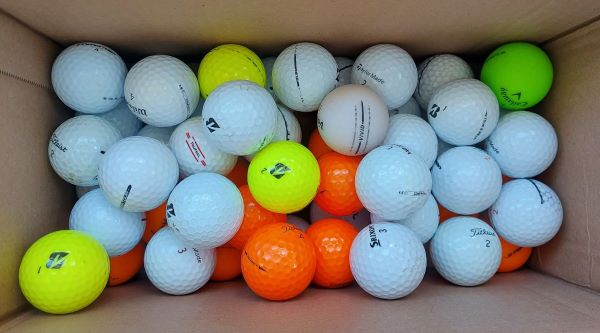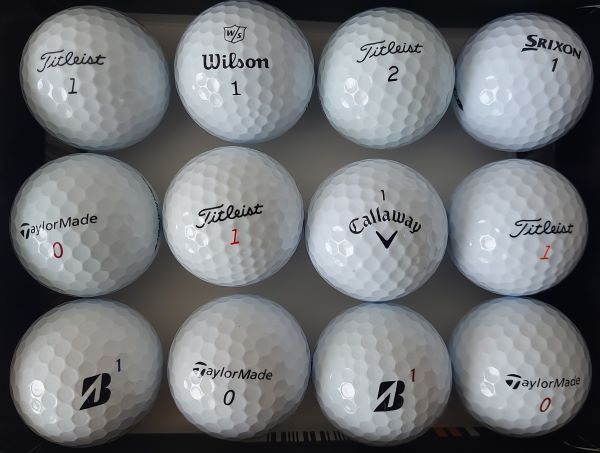When you think about it, golf balls are amazing. How can that little thing travel so far and be so accurate? Then, how can it hold its line? Did you ever think about golf ball dimples and their role in all of that? If you landed on this article, you did ask yourself questions about golf ball dimples. There is a lot to unpack there. A lot of physics and modern design have a lot to do with it.
Every year there are advantages in golf ball evolution, including dimple design. Manufacturers are coming up with new engineering solutions that make the ball go farther and straighter. Well, it also depends on what the ball’s main purpose is. As you know, there are balls made for distance, balls made for feel, and balls made for professional and highly skilled golfers.
However, all balls have one thing in common, and that thing is dimples. Without them, balls would not be able to do anything we see them do when we golf. There are no simple words to describe what makes the golf balls move through the air as we know it. Nonetheless, I will do my best to bring this to you and answer the question of how dimples work. Moving on…
Aerodynamic Drag Reduction
What else to start with but aerodynamics? When a golf ball is in flight, it creates a layer called a boundary layer. That layer clings to the surface of the ball due to viscosity (the stickiness of fluids). Additionally, the boundary layer can become turbulent, which leads to increased drag. Drag is the force that opposes the motion of the ball through the air and can slow it down.
Dimples disrupt the smooth flow of air over the ball’s surface. Consequently, by doing that they are effectively tripping the boundary layer from laminar (smooth) to turbulent flow. This turbulent boundary layer “sticks” to the surface better, reducing overall drag. That phenomenon is known as the “dimpled golf ball effect.” This is the main principle of how golf balls can travel through the air stably. Without drag reduction, the golf ball would be all over the place after you hit it.
Magnus Effect and Lift
Now we are tapping into more advanced things here. It has all to do with spin, no matter how much spin you put on the ball. When a golf ball is struck with backspin or topspin, it begins to rotate around its axis. This spin creates differences in air pressure on different sides of the ball. According to Bernoulli’s principle, faster-moving air has lower pressure. The side of the ball with backspin moves against airflow. On the other hand, the side with topspin moves with airflow.
This creates a pressure differential, causing the ball to experience lift. The ball’s topspin side has lower pressure. That allows the higher-pressure air on the backspin side to push the ball upward. This lift force counteracts the force of gravity. With that, it enables the ball to stay in the air longer and achieve greater distances.
The dimples play a key role in the Magnus effect. They help maintain a thin layer of turbulent air around the ball. Hence they allow the pressure differences to develop more effectively. The backspin side experiences less drag due to the dimples’ turbulent boundary layer. Therefore, it allows the lift force to be more pronounced. This is so fascinating, as without the Magnus effect the ball would not go anywhere.

Stability and Control
Dimples contribute to the stability and control of the ball’s flight in the following ways:
- First, the dimples help distribute the flow of air more evenly across the ball’s surface. This minimizes the impact of small imperfections and inconsistencies on the ball’s trajectory. As a result, it leads to a more consistent flight.
- Second, the turbulent boundary layer created by dimples adds a layer of stability. This prevents the ball from experiencing sudden shifts in its flight path due to changes in airflow.
Preventing “Knuckling”
Without dimples, a smooth ball would experience turbulent flow at a lower speed. That would cause it to “knuckle” or wobble unpredictably in the air. Dimples help delay this turbulent flow, allowing the ball to maintain a stable flight even at higher speeds. Can you imagine hitting the ball and watching it fly around like a deflating balloon? It is a funny image, right?
Penetrating Flight
Dimples help the ball achieve a more penetrating flight trajectory. This trajectory is often desirable because it cuts through the air more efficiently. Furthermore, it reduces the effects of crosswinds and other external factors that can divert the ball off course. I wish dimples helped us hit the shots we want all the time.

Types of Golf Ball Dimples
Golf ball dimples come in various shapes, sizes, and patterns. Each of those is designed to optimize aerodynamic performance, flight characteristics, and overall ball behavior. Different manufacturers may use their own proprietary designs, but there are a few common types:
1. Traditional Spherical Dimples
The most common dimples on golf balls. They are circular and arranged in a pattern across the ball’s surface. This pattern is often hexagonal or pentagonal, similar to a soccer ball. These dimples provide a good balance between lift, drag reduction, and stability.
2. U-Shaped Dimples
Some golf balls feature dimples with a U-shaped profile. These dimples have a curved bottom and straight sides. That resembles a rounded “U”. Nonetheless, the design aims to enhance lift and distance by promoting better airflow around the dimple edges.
3. Dual-Dimple Technology
This design includes two different sizes of dimples on the ball’s surface. Larger dimples around the ball’s equator enhance lift, while smaller dimples near the poles reduce drag. Thus, this combination optimizes the ball’s flight trajectory.
4. Dimple Depth Variability
Some golf balls have varying depths of dimples across the surface. Deeper dimples might be placed in specific areas to modify spin rates or trajectories. Consequently, they offer more control to skilled players.
5. Non-Uniform Dimple Patterns
Certain golf balls have irregular or non-uniform dimple patterns. These patterns are strategically designed to manipulate the ball’s flight characteristics. That primarily refers to trajectory, spin, and stability.
6. Seamless Dimples
Instead of discrete dimples, some golf balls have a textured surface with a continuous pattern. It often resembles the traditional dimple arrangement. In brief, this design aims to reduce drag and provide a unique aerodynamic effect.
7. Micro-Dimples
They are very shallow, tiny dimples that cover the surface of the ball in addition to the main dimples. Micro-dimples help improve airflow over the ball and can contribute to lower drag.
8. Aerodynamic Dimple Designs
Finally, manufacturers might experiment with various dimple designs. For example, designs such as scallops, fins, or even more complex patterns inspired by nature. These designs can influence how the ball interacts with the air. In addition, that might lead to specific flight characteristics.
Design Doesn’t Matter
I bet you did not know, as I didn’t, that there is so much involved with dimples on golf balls. So much physics and different principles are involved in engineering these small patterns. The science behind golf ball dimples is truly remarkable.
On one hand, the dimples reduce drag and help lift the ball. Simultaneously, they stabilize flight and shape trajectory. They are the ones to thank our shots look so great when well executed. I wonder if there is going to be some new engineering required when the golf ball rollback kicks in.
Finally, it does not matter what kind of dimples your golf ball has. What matters is that that golf ball does what you want it to. If not every time, at least most of the time.
Which golf balls do you use? What is their dimple pattern? Comment below
Related
- Does More Dimples on a Golf Ball Mean More Distance?
- How Are Modern Golf Balls Made – The Technology Behind

